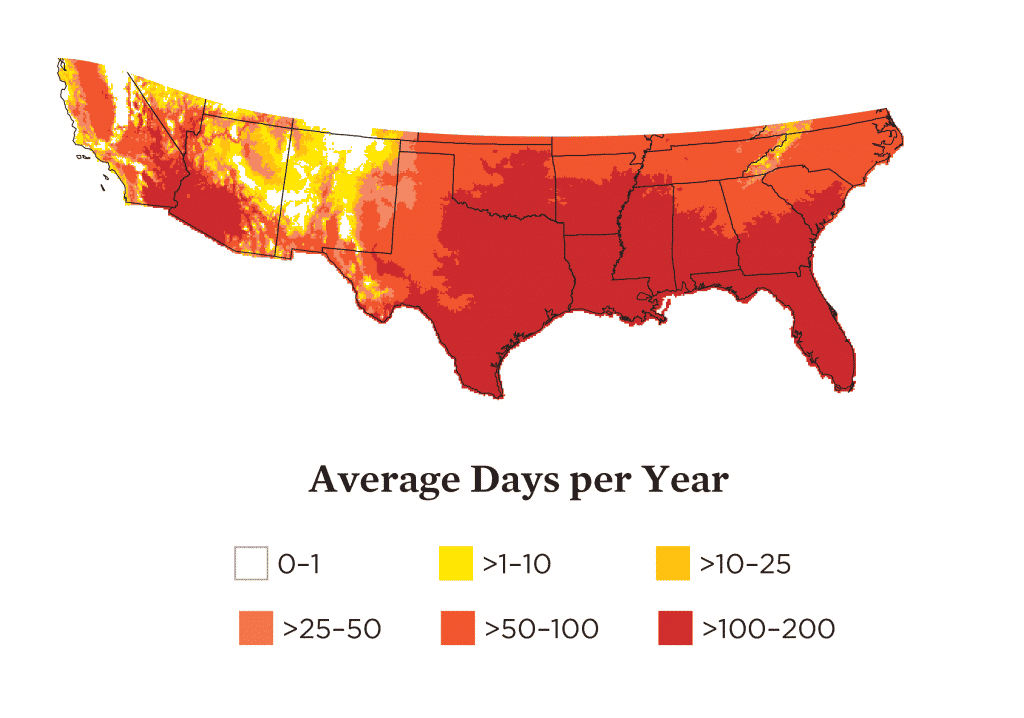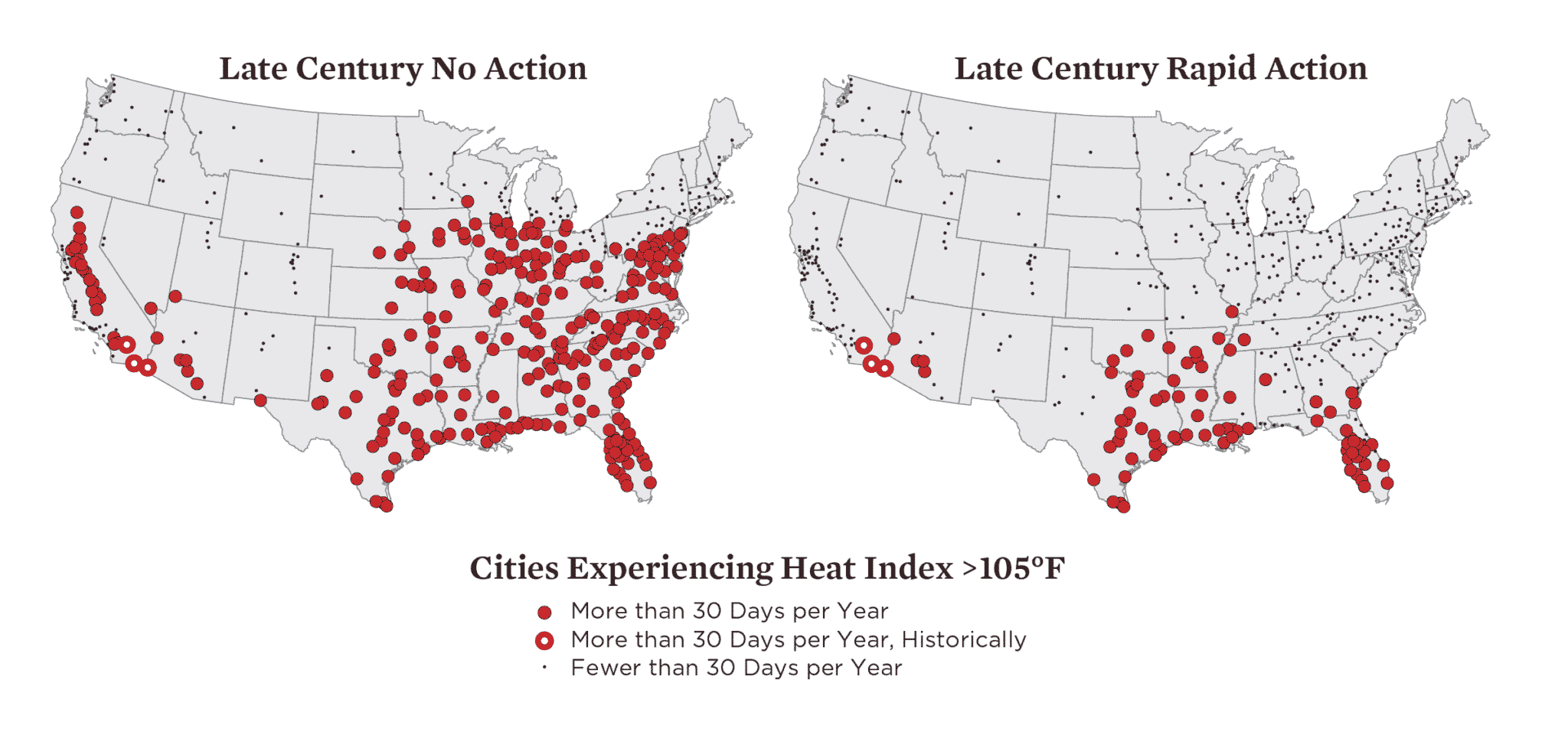
Will the U.S. Be a Dystopian Hellscape in 2100 if Emissions Keep Rising?

Night long exposure photograph of wildifires in Santa Clarita, California. FrozenShutter / E+ / Getty Images
By Kristy Dahl
Last week, UCS released Killer Heat, a report analyzing how the frequency of days with a dangerously hot heat index — the combination of temperature and humidity the National Weather Service calls the “feels like” temperature — will change in response to the global emissions choices we make in the coming decades.
When I’m deep in an analysis, like the one for Killer Heat and its companion peer-reviewed article, I often have trouble sleeping. I lie awake in the middle of the night trying to get bits of troublesome computer code to work in my head or thinking through all of the boxes that need to be checked before we start writing the report. The Killer Heat analysis kept me awake for an entirely different reason: the results terrified me.
An Unrecognizably Hot Future
To get a sense of why, project yourself, for a moment, into the future: It’s late in the century, sometime between 2070 and 2099. We’ve stayed on our current global carbon emissions path, and the rise in emissions has continued to outpace our efforts to cut them. Kids who were in elementary school in 2019 are retiring, and this is their United States:
- For the equivalent of a week or more each year, about 120 million people across the country are exposed to conditions so hot, the heat index (or “feels like” temperature) surpasses the limits of the National Weather Service’s heat index charts. The upper limit of the heat index scale falls at or above 127°F, depending on temperature and humidity. In other words, they step outside and are hit with a wall of heat that feels upwards of 130°F. How far upwards? That we don’t know.
- In 47 of the lower 48 states, these “off-the-charts” conditions occur in at least one county at least once a year. When this happens, the National Weather Service cannot reliably calculate the heat index. Historically, “off-the-charts” conditions have only occurred in the Sonoran Desert region, along the California-Arizona border, and only for a few days each year.

By late century, with no action to reduce emissions, more than 60% of the U.S. would experience at least one “off-the-charts” day in an average year. These conditions are so hot they exceed the National Weather Service’s heat index scale. They historically have affected less than 1% of the U.S. in an average year.
- The number of days per year that feel like 105°F or hotter is eight times higher than it has been historically. Every major city in Indiana, Illinois, and Iowa — and a total of more than 290 populous U.S. cities (greater than 50,000 people) — swelters for the equivalent of a month of such conditions in an average year. [Map showing cities with 30+ days of 105+ conditions (late century, no action)]
- Every major city in Michigan experiences 30 or more days per year with a heat index above 100°F, except Muskegon, which averages 29. (Cities in Wisconsin and Minnesota are no better off.)
- Residents of Tampa, Florida, Laredo, Texas, and 15 more large cities in Florida and Texas endure 150 days or more per year with a heat index above 100°F.

With no action to reduce emissions, by late century large swaths of the Sunbelt would experience more than 100 days per year with a heat index above 100 degrees Fahrenheit.
- Famously cool places average 30 days or more with a heat index above 90°F: Seattle, Washington (30); Portland, Maine (48); Portland, Oregon (53). (In Seattle, two-thirds of homes currently lack air-conditioning.)
- In more than 80 counties across Texas and Florida, in an average year, the heat index is above 90°F for half the year (180 days). In broad strokes, that means that spring is very hot, fall is very hot, and summer can be downright deadly.
It’s an unfathomably hot future, and it’s the one we’re on track to hand off to our children and grandchildren. Where do we encourage our children to settle down in this world? Will it be safe for their children play outside in the summer? And what do we tell Gen Z today when they strike and march and plead with us to change course?
Choosing a Safer Future
As my coauthors and I began to dig more deeply into our results, a second potential future came into clearer focus: In this future, rapid, aggressive action to reduce global emissions has limited global warming to 2°C above pre-industrial temperatures. These ambitious actions still lead to a future in which the number of days with a dangerously high heat index above 105°F is nearly four times what it is today, and 85 of the bigger U.S. cities would endure a month or more of such conditions.
Clearly, we need to be aiming for even greater, even faster cuts to our emissions. Yet limiting future warming to 2°C would yield a future far more recognizable to today’s children than the one we’re recklessly barreling toward, in which 290 cities suffer under such heat.

Rapidly and aggressively reducing emissions would limit the number of cities that would experience 30 days or more per year with a heat index above 105 degrees Fahrenheit.
That’s the future I have to focus on so I can sleep at night. Ensuring this safer future will require us to act on two major fronts: reducing emissions swiftly so that we can achieve net-zero carbon emissions by midcentury and limit future global warming; and building our resilience to extreme heat through a suite of common sense measures that include enacting a national heat safety standard for outdoor workers and ensuring that communities have heat warning systems in place that draw on the best available public health information.
This future may be the next-best thing to the one we’d ideally hand off to our children, but it’s a hell of a lot better than the one we’re currently heading toward. The best time to boldly begin pursuing this safer future was 20 years ago. The next-best time is now.
Kristina Dahl is a climate scientist with the Union of Concerned Scientists.

 233k
233k  41k
41k  Subscribe
Subscribe 